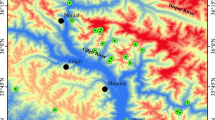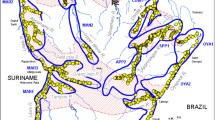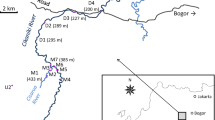Abstract
Total mercury (HgTOT), inorganic mercury (IHg), and methylmercury (MHg) were determined in dry season waters, sediments, and tailings from an active mine which has long history of gold exploitation. Although HgTOT in waters was generally low (0.03 to 19.60 ng L−1), the majority of the samples had proportions of MHg of at least 90 % of HgTOT which denotes a substantial methylation potential of the mine watersheds. Mercury was relatively high in tailing materials (up to 867 μg kg−1) and also in the mine sediments (up to 837 μg kg−1) especially in samples collected near tailing storage facilities and within a receiving water dam. Sediment profiles revealed mercury enrichment and enhanced methylation rate at deeper layers. The presence of IHg and decaying plants (organic matter) in the watersheds as well as the anoxic conditions of bulk sediments are believed to be some of the key factors favoring the mercury methylation at the site.







Similar content being viewed by others
References
AGA. (2009). AngloGold Ashanti West Wits Environmental Management Programme Report. Johannesburg: WSP Environmental.
AGA (2013). AngloGold Ashanti West Wits Operations, Social and Labour Plan Report: Half Year 2013. http://www.anglogoldashanti.com/en/sustainability/MiningCharter/Social%20and%20Labour%20Plans/2013HalfYearSocialandLabourPlanReportWestWits.pdf. Accessed 07 July 2015.
Ashley, R.P., Rytuba, J.J., Rogers. R., Kotlyar, B.B. & Lawler, D. (2002). Preliminary report on mercury geochemistry of placer gold dredge tailings, sediments, bedrock, and waters in the clear creek restoration area, Shasta County, California. U.S. Geological Survey Open-File Report 02–401, pp47.
Bełdowski, J., Miotk, M., & Pempkowiak, J. (2015). Methylation index as means of quantification of the compliance of sedimentary mercury to be methylated. Environmental Monitoring and Assessment, 187, 498–510.
Benoit, J., Gilmour, C.C., Heyes, A., Mason, R.P. & Miller, C. (2003). Geochemical and biological controls over methylmercury production and degradation in aquatic ecosystems. In Y. Chai and O.C. Braids (Eds.), Biogeochemistry of Environmentally Important Trace Elements (pp. 262–297). Washington, DC: ACS Symposium Series 835, American Chemical Society.
Berman, M., & Bartha, R. (1996). Levels of chemical vs. biological methylation of mercury in sediments. Bulletin of Environmental Contamination and Toxicology, 36, 401–404.
Bravo-Sanchez, L. R., Ruiz Encinar, J., Fidalgo Martinez, J. I., & Sanz-Medel, A. (2004). Mercury speciation analysis in sea water by solid phase microextraction-gas chromatography-inductively coupled plasma mass spectrometry using ethyl and propyl derivatization. Matrix effects evaluation. Spectrochimic Acta. Part B: Atomic. Spectroscopy, 59B, 59–66.
Dixon, K.L. (1997). Background concentrations of metals in wetland soils on and near the Savannah River site. WSRC-MS-97-00692, Rev 1, pp. 19.
Erasmus, C.S., Sellschop, J.P.F. & Hallbauer, D.K. (1982). Major amount of mercury in native gold from upper Witwatersrand sediments. Mintek Analytical Chemistry Division Report, M54, pp23
Geerdink, R. B., Breidenbach, R., & Epema, O. J. (2007). Optimization of headspace solid-phase microextraction gas chromatography-atomic emission detection analysis of monomethylmercury. Journal of Chromatography A, 1174, 7–12.
Hammarstrom, J. M., Seal, R. R., II, Meier, A. L., & Kornfeld, J. M. (2005). Secondary sulfate minerals associated with acid drainage in the eastern US: recycling of metals and acidity in surficial environments. Chemical Geology, 215, 407–431.
Harris, R., Krabbenhoft, D. P., Mason, R., Murray, M. V., Reash, R., & Saltman, T. (2007). Ecosystem responses to mercury contamination, indicators of change. New-York: SETAC.
Hines, M. E., Horvatt, M., Fagneli, J., Bonzongo, J. C. J., Batkay, T., Major, E. B., Scott, K. J., Bailey, E. A., Warwick, J. J., & Lyons, W. B. (2000). Mercury biogeochemistry in the Idrija River, Slovenia, from the above the mine into the Gulf of Trieste. Environmental Research, 83, 129–139.
Hines, N. A., Brezonik, P. L., & Engstrom, D. R. (2004). Sediment and porewater profiles and fluxes of mercury and methylmercury in a small seepage lake in northern Minnesota. Environmental Science & Technology, 38, 6610–6617.
Huang, J. H. (2005). Artifact formation of methyl- and ethyl-mercury compounds from inorganic mercury during derivatization using sodium tetra(n-propyl)borate. Analytica Chimica Acta, 532, 113–120.
Jia, X. Y., Gong, D. R., Han, Y., Wei, C., Duan, T. C., & Chen, H. T. (2012). Fast speciation of mercury in seawater by short-column high-performance liquid chromatography hyphenated to inductively coupled plasma spectrometry after on-line cation exchange column preconcentration. Talanta, 88, 724–729.
Kelly, C. A., Rudd, J. W. M., St. Louis, V. L., & Heyes, A. (1995). Is total mercury concentration a good predictor of methyl mercury concentration in aquatic systems? Water, Air, and Soil Pollution, 80, 715–724.
Kortatsi, B.K. (2006). Concentration of trace metals in boreholes in the Ankobra Basin, Ghana. West African Journal of Applied Ecology. www.ajol.info/index.php/wajae/article/view/45706/29185. Accessed 29 November 2011.
Lacerda, L. D., & Salomons, W. (1998). Mercury from gold and silver mining: a chemical time bomb? New-York: Springer.
Lusilao-Makiese, J., Tessier, E., Amouroux, D., Tutu, H., Chimuka, L., & Cukrowska, E. M. (2012). Speciation of mercury in South African coals. Toxicological & Environmental Chemistry, 94(9), 1688–1706.
Lusilao-Makiese, J. G., Cukrowska, E. M., Tessier, E., Amouroux, D., & Weiersbye, I. (2013). The impact of post gold mining on mercury pollution in the West Rand region, Gauteng, South Africa. Journal of Geochemical Exploration, 134, 111–119.
Lusilao-Makiese, J. G., Tessier, E., Amouroux, D., Tutu, H., Chimuka, L., Weiersbye, I., & Cukrowska, E. M. (2014). Seasonal distribution and speciation of mercury in a gold mining area, North West province, South Africa. Toxicological & Environmental Chemistry, 96(3), 387–402.
MacDonald, D. D., Ingersoll, C. G., & Berger, T. A. (2000). Development and evaluation of consensus-based sediment quality guidelines for freshwater ecosystems. Archives of Environmental Contamination and Toxicology, 39, 20–31.
Mao, Y., Liu, G., Meichel, G., Cai, Y., & Jiang, G. (2008). Simultaneous speciation of monomethylmercury and monoethylmercury by aqueous phenylation and purge-and-trap preconcentration followed by atomic spectrometry detection. Analytical Chemistry, 80(18), 7163–7168.
McCarthy, T. S., & Rubidge, B. (2005). The story of Earth and life: a southern African perspective on a 4.6 billion-year journey. Cape Town: Struik Publishers.
McCarthy, T. S., & Venter, J. S. (2006). Increasing pollution levels on the Witwatersrand recorded in the peat deposits on the Klip River wetland. South African Journal of Science, 102, 27–34.
Monperrus, M., Tessier, E., Veschambre, S., Amouroux, D., & Donard, O. (2005). Simultaneous speciation of mercury and butyltin compounds in natural waters and snow by propylation and species-specific isotope dilution mass spectrometry analysis. Analytical and Bioanalytical Chemistry, 381, 854–862.
Naicker, K., Cukrowska, E., & McCarthy, T. S. (2003). Acid mine drainage arising from gold mining activity in Johannesburg, South Africa and environs. Environmental Pollution, 22, 29–40.
Pestan, M. H. D., Lechler, P., Formoso, M. L. L., & Miller, J. (2000). Mercury in sediments from gold and copper exploitation areas in the CamaquaÄ River Basin, Southern Brazil. Journal of South American Earth Sciences, 13, 537–547.
Robb, L.J. & Robb, V.M. (1998). Gold in the Witwatersrand basin. In: M.G.C. Wilson and C.R. Anhaeusser (Eds), The Mineral Resources of South Africa (pp. 294–349), Council for Geoscience, South Africa, Handbook 16.
Santos-Francés, F., García-Sánchez, A., Alonso-Rojo, P., Contreras, F., & Adams, M. (2011). Distribution and mobility of mercury in soils of a gold mining region, Cuyuni river basin, Venezuela. Journal of Environmental Management, 92(4), 1268–1276.
Schubert, P., Rosenberg, E., & Grasserbauer, M. (2000). Comparison of sodium tetraethylborate and sodium tetra(n-propyl)borate as derivatization reagent for the speciation of organotin and organolead compounds in water samples. Fresenius Journal of Analytical Chemistry, 366, 356–360.
Shao, D., Kang, Y., Wu, S., & Wong, M. H. (2012). Effects of sulfate reducing bacteria and sulfate concentrations on mercury methylation in freshwater sediments. Science of the Total Environment, 424, 331–336.
Sonke, J. E., Heimburger, L.-E., & Dommergue, A. (2013). Mercury biogeochemistry: paradigm shifts, outstanding issues and research needs. Comptes Rendus Geoscience, 345, 213–224.
Stoichev, T., Amouroux, D., Rodriguez Martin-Doimeadios, R. C., Monperrus, M., Donard, O. F. X., & Tsalev, D. L. (2006). Speciation analysis of mercury in aquatic environment. Applied Spectroscopy Reviews, 41, 591–619.
USEPA. (1992). Water quality standards, establishment of numeric criteria for priority toxic pollutants. States’ compliance, final rule. Federal Register, 40 CFR Part, 131(246), 847–860.
Vorosmarty, C. J., Meybeck, M., Fekete, B., Sharma, K., Green, P., & Syvitski, J. P. M. (2003). Anthropogenic sediment retention: major global impact from registered river impoundments. Global and Planetary Change, 39, 169–190.
Walters, C. R., Somerset, V. S., Leaner, J. J., & Nel, J. M. (2011). A review of mercury pollution in South Africa: current status. Journal of Environmental Science and Health, Part A, 46, 1129–1137.
Winch, S., Fortin, D., Lean, D. R. S., & Parsons, M. (2008). Factors affecting methylmercury levels in surficial tailings from historical Nova Scotia gold mines. Geomicrobiology Journal, 25(2), 112–129.
Yan, H., Feng, X., Shang, L., Qiu, G., Dai, Q., Wang, S., & Hou, Y. (2008). The variations of mercury in sediment profiles from a historically mercury-contaminated reservoir, Guizhou province, China. Science of the Total Environment, 407, 497–506.
Yin, Y. G., Chen, M., Peng, J. F., Liu, J. F., & Jiang, G. B. (2010). Dithizone-functionalized solid phase extraction–displacement elution-high performance liquid chromatography–inductively coupled plasma mass spectrometry for mercury speciation in water samples. Talanta, 81, 1788–1792.
Acknowledgments
The authors would like to express their gratitude to the French National Centre for Scientific Research (CNRS) and the Laboratory of Analytical, Bio-Inorganic and Environmental Chemistry (LCABIE, France) for the financial support and for the access to their facilities and The National Research Foundation-Technology and Human Resources for Industry Programme (NRF-THRIP, SA) and the Wits University Research Committee (URC, SA) for funding our research.
Author information
Authors and Affiliations
Corresponding author
Rights and permissions
About this article
Cite this article
Lusilao-Makiese, J.G., Tessier, E., Amouroux, D. et al. Mercury speciation and dispersion from an active gold mine at the West Wits area, South Africa. Environ Monit Assess 188, 47 (2016). https://doi.org/10.1007/s10661-015-5059-4
Received:
Accepted:
Published:
DOI: https://doi.org/10.1007/s10661-015-5059-4




